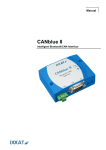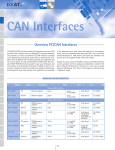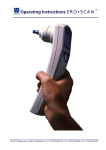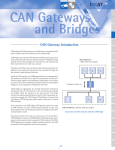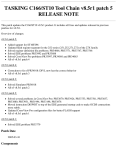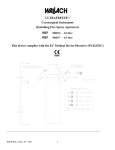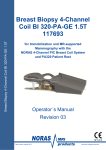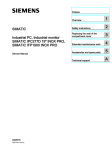Download USB-to-CAN II
Transcript
Manual USB-to-CAN II Intelligent PC/CAN Interface The expert for industrial and automotive communication IXXAT Headquarter IXXAT Automation GmbH Leibnizstr. 15 D-88250 Weingarten US Sales Office IXXAT Inc. 120 Bedford Center Road USA-Bedford, NH 03110 Tel.: +49 (0)7 51 / 5 61 46-0 Fax: +49 (0)7 51 / 5 61 46-29 Internet: www.ixxat.de e-Mail: [email protected] Phone: +1-603-471-0800 Fax: +1-603-471-0880 Internet: www.ixxat.com e-Mail: [email protected] Support In case of unsolvable problems with this product or other IXXAT products please contact IXXAT in written form by: Fax: +49 (0)7 51 / 5 61 46-29 e-Mail: [email protected] For customers from the USA/Canada Fax: +1-603-471-0880 e-Mail: [email protected] Copyright Duplication (copying, printing, microfilm or other forms) and the electronic distribution of this document is only allowed with explicit permission of IXXAT Automation GmbH. IXXAT Automation GmbH reserves the right to change technical data without prior announcement. The general business conditions and the regulations of the license agreement do apply. All rights are reserved. Document number: 4.01.0066.20000 Version: 1.5 Contents 1 Introduction .............................................................................. 5 1.1 Overview ............................................................................. 5 1.2 Features .............................................................................. 5 1.3 Support ............................................................................... 6 1.4 Returning hardware ............................................................ 6 2 Installation................................................................................. 7 2.1 Software installation .......................................................... 7 2.2 Hardware installation ......................................................... 7 3 Connections and displays .......................................................... 7 3.1 Pin allocation ...................................................................... 7 3.1.1 3.1.2 3.1.3 3.1.4 USB connector ........................................................................... 7 CAN bus connector for CAN 1 ................................................... 7 CAN bus connector for CAN 2 ................................................... 8 Cable adapter RJ45 to Sub-D9M ................................................ 9 3.2 Displays ............................................................................. 10 3.2.1 3.2.2 3.2.3 3.2.4 USB LED .................................................................................. 10 CAN LEDs (CAN1 and CAN2) ................................................... 11 CAN1 LS LED (only variant automotive) .................................... 12 LIN LED (only variant automotive) ............................................ 12 3.3 CAN bus termination ........................................................ 12 3.4 LIN (only variant automotive) ........................................... 12 4 Appendix ................................................................................. 13 4.1 Technical specifications ..................................................... 13 4.2 Accessories ........................................................................ 14 4.2.1 CAN bus termination resistor ................................................... 14 4.2.2 Cable adapter RJ45 to Sub-D9M .............................................. 15 4.3 Notes on EMC ................................................................... 15 Declaration of conformity ....................................................... 16 FCC Compliance ....................................................................... 17 Copyright IXXAT Automation GmbH 3 USB-to-CAN II - Manual, V1.5 Introduction 1 Introduction 1.1 Overview Congratulations on your purchase of the IXXAT PC/CAN interface USB-to-CAN II, a high-quality electronic component developed and manufactured according to the latest technological standards. This manual is intended to familiarize you with your interface, also referred to in the following as USB-to-CAN II. Please read this manual before beginning with the installation. 1.2 Features • • • • • • • • According to USB specification version 2.0 “Hot-plug“ compatible (plug-in during operation of computer) Power supply via USB Infineon 16 bit microcontroller with 36MHz clock 512 kByte RAM 512 kByte Flash 2 CAN controller PHILIPS SJA1000 with 16 MHz clock variant industrial: CAN bus interface according to ISO 11898-2, as an option galvanically isolated (both CAN circuits have a common potential) • variant automotive: CAN bus interface on CAN 1 can be choosen between high- (ISO 11898-2) and low-speed (ISO 11898-3), galvanically isolated (both CAN circuits have a common potential) CAN bus interface on CAN 2 according to ISO 11898-2, galvanically isolated LIN bus interface, galvanically isolated (common potential with the CAN bus interfaces) Copyright IXXAT Automation GmbH 5 USB-to-CAN II - Manual, V1.5 Introduction CAN-Controller SJA1000 USB cable Low-Speed TJA1054 MC C161U 36MHz CAN-Controller SJA1000 High-Speed SN65HVD251 CAN1 High-Speed SN65HVD251 CAN2/LIN SRAM (512 kB) optional galvanic isolation CAN socket Flash (512 kB) CAN potential CAN socket USB potential LIN TJA1020 LEDs only for variant automotive Picture 1-1: Block diagram of the USB-to-CAN II 1.3 Support For more information on our products, FAQ lists and installation tips, please refer to the support section of our website (http://www.ixxat.de), which also contains information on current product versions and available updates. If you have any further questions after studying the information on our website and the manuals, please contact our support department. The support section on our website contains the relevant forms for your support request. In order to facilitate our support work and enable a fast response, please provide precise information on the individual points and describe your question or problem in detail. If you would prefer to contact our support department by phone, please also send a support request via our website first, so that our support department has the relevant information available. 1.4 Returning hardware If it is necessary to return hardware to us, please download the relevant RMA form from our homepage and follow the instructions on this form. In the case of repairs, please also describe the problem or fault in detail on the RMA form. This will enable us to carry out the repair quickly. Copyright IXXAT Automation GmbH 6 USB-to-CAN II - Handbook, V1.5 Installation 2 Installation 2.1 Software installation A driver is required to operate the interface. This driver is part of the VCI (Virtual CAN Interface), which could be downloaded for free in the internet (http://www.ixxat.de). For installation of the CAN driver VCI under Windows, please refer to the VCI installation manual. 2.2 Hardware installation The USB-to-CAN II can be plugged in and unplugged during operation of the PC (hot-plug compatible). It is recommended to install the VCI software before plugging in for the first time. 3 Connections and displays 3.1 Pin allocation 3.1.1 USB connector The USB connector is designed as a type “A“ connector. Pin allocation is according to the USB standard. The shield of the USB cable is connected to the ground of the PCB via a 1MΩ resistor and a 1nF capacitor. The USB-to-CAN II could only be connected to self-powered hubs (USB-hubs with own power supply) or directly to the PC 3.1.2 CAN bus connector for CAN 1 The USB-to-CAN II has a bus interface according to ISO 11898-2, optionally configurable as ISO 11898-3 (only variant automotive). The signals of the bus interface are connected to the 8-pin RJ45 connector (see table 3-1). The bus interface can be galvanically isolated from the CAN bus as an option. Copyright IXXAT Automation GmbH 7 USB-to-CAN II - Manual, V1.5 Connections and displays Pin No. X5 Signal 1 2 3 4 CAN high CAN low GND CAN high (Fault Tolerant), (only variant automotive) CAN low (Fault Tolerant), (only variant automotive) Not connected GND Not connected 5 6 7 8 Table 3-1: Pin allocation of the CAN bus connector The shield of the CAN connector is connected to the ground of the CAN bus interface via a 1MΩ resistor and a 1nF capacitor. The shields of both CAN connectors are directly connected together. In case of a non galvanically decoupled device the CAN ground and the USB ground have a common potential. For the best results of noise immunity the shields of the CAN cables should be grounded. 3.1.3 CAN bus connector for CAN 2 The USB-to-CAN II has a bus interface according to ISO 11898-2, optionally with LIN interface (only variant automotive). The signals of the bus interface are connected to the 8-pin RJ45 connector (see table 3-2). The bus interface can be galvanically isolated from the CAN and LIN bus as an option. Pin No. X6 Signal 1 2 3 4 5 6 7 8 CAN high CAN low GND Not connected Not connected LIN (only variant automotive) GND V-LIN (12V DC, max. 200mA) (only variant automotive) Table 3-2: Pin allocation of the CAN bus connector Copyright IXXAT Automation GmbH 8 USB-to-CAN II - Handbook, V1.5 Connections and displays The shield of the CAN connector is connected to the ground of the CAN bus interface via a 1MΩ resistor and a 1nF capacitor. The shields of both CAN connectors are directly connected together. In case of a non galvanically decoupled device the CAN ground and the USB ground have a common potential. For the best results of noise immunity the shields of the CAN cables should be grounded. 3.1.4 Cable adapter RJ45 to Sub-D9M The connection of the cable adapter could be seen in table 3-3. The cable could be ordered at IXXAT with the ordering number 1.04.0074.01000. Picture 3-1: Cable adapter RJ45 to Sub-D9M Pin No. Sub-D9M 7 2 3 4 1 5 6 9 Pin No. RJ45 1 2 3 4 5 6 7 8 8 Not connected Shield Shield Table 3-3: Pin assignment of the cable adapter Copyright IXXAT Automation GmbH 9 USB-to-CAN II - Manual, V1.5 Connections and displays 3.2 Displays The USB-to-CAN II has 3 LEDs in the variant industrial and 5 LEDs in the variant automotive. The LEDs show the communication status of the according interface. Picture 3-2: Connectors and LEDs of the variant industrial Picture 3-3 Connectors and LEDs of the variant automotive 3.2.1 USB LED The USB LED signals the operating state of the device. If the LED is green, communication via USB is possible. If the LED is off, there’s no communication possible. In case of a green flashing USB LED, the level of the USB voltage may be too low for safety CAN communication. But this is only a hint of the interface, there’s no limitation in use of the CANs. Copyright IXXAT Automation GmbH 10 USB-to-CAN II - Handbook, V1.5 Connections and displays Flashing Description mode off No communication via USB possible Causes/Hints green USB communication possible • Device fully functional green blinking USB communication • The CAN components need a voltpossible, may be the USB voltage of 5V DC ±5%, but the USB age is to low for a properly voltage is under the lower limit at CAN communication the moment CAN communication is still possible! • Device not properly initialised, because the USB port can’t provide enough power • Device not connected to USB Table 3-4: States of the USB LED 3.2.2 CAN LEDs (CAN1 and CAN2) The two coloured (green and red) LEDs for CAN1 and CAN2 flash on each CAN message (transmitted or received) green, if there was no error detected. If the CAN controller is in the „Error warning“ or „Error passive“ state, the LED flashes red on each message. In the „Bus off“ state the LED is continously red. Flashing mode off Description Causes/Hints No CAN communication • No CAN communication • Device not connected to CAN green / green CAN communication • With each CAN message the LED is trigblinking gered red blinking CAN communication, • The CAN controller is in the „Error CAN controller in erWarning“ or „Error passive“ state, the ror state reception/transmission of CAN messages is still possible red Bus Off • The CAN controller is in the „Bus Off“ state. No more CAN communication possible Table 3-5: States of the CAN LEDs Copyright IXXAT Automation GmbH 11 USB-to-CAN II - Manual, V1.5 Connections and displays 3.2.3 CAN1 LS LED (only variant automotive) The CAN1 LS LED is yellow. It shows the active bus interface for CAN 1. If the high speed transceiver is active, the LED is off. In case of the fault tolerant transceiver, the LED is on. Flashing Description mode off CAN high speed transceiver active yellow Causes/Hints • The CAN high speed interface is activated CAN low speed (fault tolerant) transceiver active • The CAN low speed (fault tolerant) interface is activated Table 3-6: States of the CAN1 LS LED 3.2.4 LIN LED (only variant automotive) The two-coloured (green and red) LED for LIN flashes on each message, that was transmitted or received. In case of an error the LED is blinking red. Flashing mode off Description Causes/Hints No LIN communication • There is no LIN communication • Device not connected to LIN green / green LIN communication blinking • With each LIN message the LED is triggered red / red blinking • On the transmission or reception of a LIN message an error was detected LIN communication with errors Table 3-7: States of the LIN LED 3.3 CAN bus termination There is no bus termination resistor for the CAN bus assembled on the USB-toCAN II. As an accessory a bus termination resistor is available as a feed through connector at IXXAT (ordering number 1.04.0075.03000). 3.4 LIN (only variant automotive) The USB-to-CAN II can be configured as LIN Master according to LIN specification V1.3. A voltage of 12 V DC (voltage range 8-18V DC) has to connected to the CAN socket X6. The power consumption is limited by a 1kΩ resistor. Copyright IXXAT Automation GmbH 12 USB-to-CAN II - Handbook, V1.5 Appendix 4 Appendix 4.1 Technical specifications USB interface: Microcontroller: RAM / Flash: Version 2.0 (Full Speed) Infineon C161U, 36 MHz 512 kByte / 512 kByte CAN controller: 2x Philips SJA1000 CAN transceiver (high speed): Texas Instruments SN65HVD251 CAN transceiver (low speed): Philips TJA1054 Max. number of CAN bus nodes: 120 (high speed), 32 (low speed) CAN bus termination resistor: none (high speed), RTH=RTL=4,7kΩ (low speed) CAN propagation delay: with galvanic isolation typically 32 ns CAN baudrates: 10 kBaud – 1 MBaud (high speed), 10 kBaud - 125 kBaud (low speed) Max. CAN message rate 19900 messages/s (continuous) (with VCI, receive direction): 21200 messages /s (burst) Max. CAN- message rate 11300 messages /s (continuous) (with VCI, transmit direction): LIN transceiver: LIN baudrates: Max. LIN message rate: LIN voltage range: Philips TJA1020 up to 20 kBaud 2500 messages/s 8 – 18V DC, 12 V DC typically Power supply: Power consumption (normal): via USB (5V DC) typically 210 mA maximum 400 mA typically 4 mA maximum 21 mA Power consumption (standby): Housing material: Dimensions (L x B x H) in mm: Weight: Copyright IXXAT Automation GmbH ABS plastics 98 x 55 x 20 approx. 200 g 13 USB-to-CAN II - Manual, V1.5 Appendix Protection class: IP40 Operating temperature range: Storage temperature range: Relative humidity: Galvanic isolation: -20°C - +80°C -40°C - +85°C 10 - 95%, non-condensing optional CAN and LIN Bus to USB 250 V AC for 1 min Device security: CSA/UL 60950-00 Class 3862 10, 3862 90 4.2 Accessories 4.2.1 CAN bus termination resistor IXXAT offers a bus termination resistor as a feed through connector (ordering number 1.04.0075.03000). Picture 4-1: Connections of the CAN bus termination resistor Picture 4-2: CAN bus termination resistor Copyright IXXAT Automation GmbH 14 USB-to-CAN II - Handbook, V1.5 Appendix 4.2.2 Cable adapter RJ45 to Sub-D9M The cable adapter offers the possibility of connecting the USB-to-CAN II via a Sub-D9M plug to the user. The length of the cable (without the plugs) is 100 mm. The ordering number of the cable adapter is 1.04.0074.01000. Picture 4-3: Cable adapter RJ45 to Sub-D9M 4.3 Notes on EMC The PC/CAN-Interface USB-to-CAN II may only be used with a PC that has a CEsymbol. The CAN-bus connected to the interface must have a shielded lead. The shield braiding must be connected with low impedance to the connector housing. Copyright IXXAT Automation GmbH 15 USB-to-CAN II - Manual, V1.5 Appendix Declaration of conformity IXXAT Automation declares that the product: USB-to-CAN II with the article number: 1.01.0062.11110 1.01.0062.11220 1.01.0066.11220 do comply with the EC directives 2004/108/EC. Applied harmonized standards in particular: EN 55022:2006 + A1:2007 EN 55024:1998 + A1:2001 + A2:2003 22.08.2011, Dipl.-Ing. Christian Schlegel , Managing Director IXXAT Automation GmbH Leibnizstrasse 15 88250 Weingarten Copyright IXXAT Automation GmbH 16 USB-to-CAN II - Handbook, V1.5 Appendix FCC Compliance Declaration of conformity This device complies with Part 15 of the FCC Rules. Operation is subject to the following two conditions: • this device may not cause harmful interference, and • this device must accept any interference received, including interference that may cause undesired operation. Class A digital device instructions: Note: This equipment has been tested and found to comply with the limits for a Class A digital device, pursuant to Part 15 of the FCC Rules. These limits are designed to provide reasonable protection against harmful interference when the equipment is operated in a commercial environment. This equipment generates, uses, and can radiate radio frequency energy and, if not installed and used in accordance with the instruction manual, may cause harmful interference to radio communications. Operation of this equipment in a residential area is likely to cause harmful interference in which case the user will be required to correct the interference at his own expense. Copyright IXXAT Automation GmbH 17 USB-to-CAN II - Manual, V1.5


















